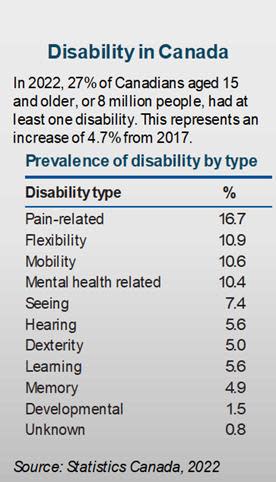Member Knowledge Centre
 member Knowledge centre
member Knowledge centre
The Knowledge Centre provides CHBA members with access to information and resources. It is a growing resource that is currently focused on updating members about national building code information. Please note that this information is a benefit of your membership, and should not be shared beyond your company/organization.
You can browse the items below, filter by category, or enter search terms in the "What are you looking for" box below.
CHBA Policy Position - Adaptability, Visitability and Accessibility

CHBA Policy Position - Adaptability, Visitability and Accessibility
October 10, 2025
 Accessibility, Adaptability and Visitability
Accessibility, Adaptability and Visitability
The Canadian Home Builders’ Association (CHBA) supports the participation of all individuals in society. CHBA recognizes that society does not always accommodate every individual’s needs which can limit their participation in society. CHBA supports accessibility for facilities and services open to the public including public spaces in residential buildings. Conversely, CHBA recognizes that Canadians view their homes as a private space that they expect to tailor to their individual needs, wants and budgets. Thus, CHBA believes that private homes should not be subject to any requirements for adaptability, visitability and accessibility that will further reduce housing affordability and choice for Canadians.
Empowering the industry |
Upon completion of the course, a CHBA Qualified Adaptiv Home Specialist have the knowledge and skills required to modify homes to accommodate individuals living with a disability, a progressive condition, or those looking to age in place. Encouraging the voluntary renovation of the 15 million existing homes in Canada through these efforts will help fulfill the expectations and needs of Canadians for housing that meets their individual needs in a manner households can afford.
Protecting affordability and choice for all Canadians
CHBA supports regulatory processes that rely on rigorous impact analysis and evidence-based decision making. The National Building Code already requires a barrier-free path of travel and barrier-free facilities in public buildings and in the public spaces of large, private, residential buildings.
However, applying accessibility requirements to the interior of all private homes (or even some private homes whose households do not need or want these features) would significantly reduce housing affordability and choice for Canadians. This is especially true for ground-oriented homes (e.g. detached, semi-detached, townhomes, stacked townhomes), which do not benefit from the barrier-free entrances that are already required for large multi-storey residential buildings. According to a study done by Accessible Standards Canada (a federal government entity) in 2023, the total additional costs to apply accessibility features from the new standard CSA B652 Accessible Dwellings to new homes ranged from $60,000 for a 2-storey, 1900 sq. ft house in Montreal to $149,000 for a 2-storey plus basement, 4 unit building in Toronto (see Appendix).
While adjusting the height of a light switch or receptacle could be a cost neutral adaptability measure, NRC estimated the cost of adding all new 2025 code-mandated adaptability measures to range between $550 and $900 (see Appendix).
However, mandating visitability features like wider hallways and bathrooms with large turning radiuses in new homes will lead to increased housing costs because these modifications require more space, land, and/or materials. In the case of ground-oriented homes, the clearances and framing space required for wider entrance doors and interior doorways may require a floor plan wider than what can be accommodated on a single, narrow lot. Similarly for taller multi-storey residential buildings, the additional space required in each unit for these measures would reduce the usable living space and lead to fewer units being constructed per building. NRC estimated the cost of adding the 2025 code-mandated Visitability requirement to range from $7,500 to $14,000 per unit (see Appendix for more details on the impact of space requirements).
Industry experience shows that accessible dwelling units are often less appealing to the general public, making them harder to sell to buyers without specific needs. This reduces demand for new accessible homes, pushing buyers toward existing non-accessible units, making it harder for new home builders to compete, and driving up prices in the existing housing market. Overregulating adaptability and visitability could therefore lead to the elimination of some forms of housing because their construction would no longer be economically feasible.
If – as proposed by the national codes – provincial and local governments were to set the minimum number or percentage of visitable dwelling units in private-market housing, builders of new projects may not find enough buyers interested in purchasing these units. Instead, governments could achieve much better policy outcomes if they prioritized incentives for homeowners who would like to adapt their existing homes for their personal needs. Alternatively, governments could finance accessible units and provide them to the public for ownership or rental, rather than placing this risk and cost burden on builders and developers.
Meeting the unique needs of all Canadians
Health professionals agree that those needing home modifications for accessibility require individual and specific renovations tailored to their unique condition. It is equally important to plan for the progression of that condition so that the renovations continue to serve their purpose into the future. The role of a CHBA Qualified Adaptiv Home Specialist is to understand the type of home adaptations the client will require, both now and in the future.
Unintended consequences must be examined if governments determine that regulating all homes is the best route for any situation, including for meeting the needs of people with disabilities. There are 8 million Canadians age 15+ living with a variety of disabilities. The reality is that different disabilities require different home modifications. Therefore, mandating adaptability and visitability requirements inside homes may not only severely impact affordability but be counterproductive by not supporting the actual requirements of the households that actually occupy them.
Focusing on the specific homes of Canadians where their daily activities are limited by a disability, progressive, or age-related condition will better serve their needs. There are 10 million Canadians age 60+, representing more than one third of the population. The vast majority are homeowners who want to live in their home for the rest of their lives. A CHBA Qualified Adaptiv Home Specialist is trained to identify safety hazards in the clients’ existing home and propose responsive design solutions for their individual needs.
Mandating adaptability and/or visitability requirements in all new private homes will compromise the availability and affordability of housing that Canadians need and want. Supporting the voluntary efforts of CHBA members to improve the accessibility of homes will help ensure that the industry can deliver housing to meet the needs, wants and budgets of all Canadians. Any further costs of providing accessible housing that are mandated in any way should be financed by governments.
Appendix – Costing and Additional Space
Cost Estimates for 2025 National Code Changes
The following presents the cost-benefit information for the approved 2025 National Building Code changes for adaptability and visitability of dwelling units:
The Adaptability requirements apply to all dwelling units including private homes that include two traditional bathtub/shower combination units. The associated costs were estimated to range from $445 to $865 per dwelling unit:
- $85 for a wider entrance door (additional cost for wider door minus savings on framing; no additional cost for additional space or design changes)
- No additional cost for lower installation height for light switches and outlets
- $180-$390 to install grab bar backing for a traditional bathtub/shower combination in a wood-framed home (less for entrance only for prefabricated tubs for which grab bars cannot be installed afterwards)
- $145-$390 to install grab bar backing for a shower in a wood-framed home (less for entrance for prefabricated showers for which grab bars cannot be installed afterwards)
The Visitability requirements apply to a set percentage (0-100%) of dwelling units in multi-unit residential buildings, which already has barrier free access. The percentage is set by the AHJ. The associated estimated cost range from $7,561 and $14,224.
- $4,695 to $8,107 to build a barrier-free path of travel
- $2,866 to $6,135 to build a visitable washroom
The cost was estimated across nine different regions and assumed a condo unit in a high-rise building of 6 to 60 storeys. The costs are in addition to the adaptability costs noted above.
Other Accessibility (non-codes) Costing Studies
According to a costing study done by Accessible Standards Canada (a federal government entity) in 2023, the total additional costs to apply accessibility features from the CSA B652 Accessible Dwellings to newly constructed houses range from $60,000 for a 2-storey, 1900 sq. ft house in Montreal to $149,000 for a 2-storey plus basement, 4 unit building in Toronto.
The main drivers of additional costs are ramps to access the front/back porch, vertical lifts to access multiple storeys, larger garage spaces. The study also points out the distribution of cost-adding features:
- 62% of features are cost-neutral (ceiling clearances, stair nosing, height of light switches)
- 23% of features add cost between $0 and $1000 (e.g. kitchen electrical, showers)
- 10% of features add $1,000 or more (heat-resistant countertops, lighting)
- 5% of features add $10,000 or more (garage space, ramps, vertical lifts)
A 2019 costing study done by CMHC of integrating accessibility into existing units of affordable housing (social housing), estimated cost ranged from
- $49,000 to $96,000[1] for modifying an existing home and making it adaptable, by providing a wheelchair-accessible at the entrance level PLUS architectural features facilitating the addition of a lift later without major renovations.
- $53,000 to $375,000[2] for modifying an existing home and making it fully accessible where a person using a wheelchair can enter and move to the inside of each room on every floor and use all the facilities.
Impact on space requirements
In their review of provincial accessibility requirements, CHBA-BC noted that one of the more significant points to accessible design will be the reallocation of space. While it’s possible to maintain the existing floor area, it is likely that there will be reductions in storage and functional living space/program elements in order to accommodate the clearances and circulation space.
The following space reallocations are from a space and cost study for Part 3 buildings:
- Bathroom floor areas increased between 24% to 46%
(46% increase for a 3 bedroom, 2 bath unit); - Changes to circulation floor areas ranged widely between 0% to 70%
(70% increase for 2 bedroom, 2 bath unit); - Storage floor areas were reduced in nearly all units between -4% to -74%
(74% decrease for a 3 bedroom, 2 bath unit); - Dining area was eliminated from a 3 bedroom, 2 bath unit
and reconfigured as an eat-in kitchen.
[1] Note that the values in this study have been calculated in 2025 dollars. 2019 costs have increased from 70-100% depending on renovation or new construction
[2] Note that this study specifically focuses on costs to move from existing to adaptable (Step 1) and then adaptable to accessible (Step 2). This cost was achieved by adding Steps 1 & 2.
Additional Info
Download File : 2025-10-10 CHBA Position on Accessibility.pdf

